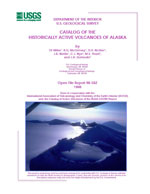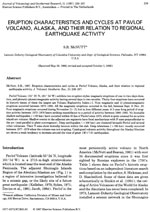Pavlof 1914/7
Start: July 6, 1914 ± 1 Days [1]
Stop: October 16, 1914 ± 3 Months [2]
Event Type: Explosive
Max VEI: 2 [3]
- Minor explosive eruption [6]
- "Fire", "Glowing", or incandescence
Description: This eruption was recorded in the log book of the US Coast and Geodetic Survey Patterson's log book. On July 6, 1914, the log book records: 'At 12:18 a distant rumbling, which some on deck took for thunder was heard. It came from a direction between W and WNW (mag) and lasted longer than thunder and sounded like a landslide with many distinct explosions and a minute later two separate explosions were heard, though faintly. At 12:30 more rumbling was heard although at this time it sounded more like thunder and seemed to be from a source higher above the horizon. At 12:30 the fog suddenly disappeared - it was flat calm and a dark blue black cloud was seen to the westward. Notified the Commanding Officers that there was probably a volcanic explosion and by this time some solid particles in the atmosphere could be felt by the eyes and soon it began to collect on the deck. A light SW-SSW breeze now sprang up and the cloud spread to the northward. Peals of thunder were heard - though not very loud - at intervals about 10 mins and at 1:30 some lighning was noticed. The cloud now spread to the southward and at 1:30 it was so dark that it was necessary to start the dyanamo. The decks were covered by 2 o'clock with a fine black dust and it was very difficult to look into the wind as it bothered the eyes so much. At 2:30 it began to brighten to the northward and soon became normal - mist to the northward with the black cloud passing over Unga and Popof Islands. At 2:05 dropped the dory - Dr. Edson left ship to answer call of SS Windber. Dory returned with the captain of the Windber. Ship lay to. 3:05 Dory returned with Dr. Edson - hoisted dory and at 3:15 squared on course ENE with the "Windber" following. 5:40 Overtook the cloud hanging over Popof and another light shower of volcanic ash was experienced at 5:30. Light SW breezes." Images of these log book pages are visible at the following URLs: http://oldweather.s3.amazonaws.com/ow3/final/USCS%20Patterson/Book%2016/IMG_6579_0.jpg and http://oldweather.s3.amazonaws.com/ow3/final/USCS%20Patterson/Book%2016/IMG_6579_1.jpg . Ther e are also transcripts from the Old Weather project: http://forum.oldweather.org/index.php?topic=384.msg74647#msg74647 .
Sapper (1917) writes that on July 5 or 6 [1914], during the night or at 6 am, there was the beginning of an eruption. There were light explosions from 12:18 to 3 pm, and loud detonations could be heard at Corvin [Unga] Island (10 to 30 minutes apart. "Stronger ashfalls."
The eruption was still evident when the steamer Dirigo passed by Pavlof on July 10, 1914: "Pavlof volcano, on the Alaska peninsula, west of the Shumagin island 100 miles off Mount Shishaldin, was also active when the Dirigo passed. The action of Pavlof was peculiar, the mountain throwing out a black ash, a light fall of which was noticed on the Dirigo" (Associated Press, 1914).
On Friday, October 16, 1914, the US Coast and Geodetic Survey's Patterson vessel again noted eruptive activity from Pavlof: "Pavlof volcano was seen in active eruption - dense volumes of smoke and flame reaching several thousand feet above the crater were seen. No noise could be heard and only a very slight trace of ashes could be detected." (see log book images here: http://oldweather.s3.amazonaws.com/ow3/final/USCS%20Patterson/Book%2017/IMG_6692_1.jpg and http://oldweather.s3.amazonaws.com/ow3/final/USCS%20Patterson/Book%2017/IMG_6692_0.jpg )
The United States Commissioner at Unga gave T.A. Jaggar black sand that fell at Unga from Pavlof during a July 6, 1914 eruption (Kennedy and Waldron, 1955). Coats (1955) start date of July 15, 1914 is certainly too late for the beginning of the eruption.
Sapper (1917) writes that on July 5 or 6 [1914], during the night or at 6 am, there was the beginning of an eruption. There were light explosions from 12:18 to 3 pm, and loud detonations could be heard at Corvin [Unga] Island (10 to 30 minutes apart. "Stronger ashfalls."
The eruption was still evident when the steamer Dirigo passed by Pavlof on July 10, 1914: "Pavlof volcano, on the Alaska peninsula, west of the Shumagin island 100 miles off Mount Shishaldin, was also active when the Dirigo passed. The action of Pavlof was peculiar, the mountain throwing out a black ash, a light fall of which was noticed on the Dirigo" (Associated Press, 1914).
On Friday, October 16, 1914, the US Coast and Geodetic Survey's Patterson vessel again noted eruptive activity from Pavlof: "Pavlof volcano was seen in active eruption - dense volumes of smoke and flame reaching several thousand feet above the crater were seen. No noise could be heard and only a very slight trace of ashes could be detected." (see log book images here: http://oldweather.s3.amazonaws.com/ow3/final/USCS%20Patterson/Book%2017/IMG_6692_1.jpg and http://oldweather.s3.amazonaws.com/ow3/final/USCS%20Patterson/Book%2017/IMG_6692_0.jpg )
The United States Commissioner at Unga gave T.A. Jaggar black sand that fell at Unga from Pavlof during a July 6, 1914 eruption (Kennedy and Waldron, 1955). Coats (1955) start date of July 15, 1914 is certainly too late for the beginning of the eruption.
References Cited
[1] Katalog der geschichtlichen vulkanausbruche, 1917
Sapper, Karl, 1917, Katalog der geschichtlichen vulkanausbruche: Strassburg, Germany, Karl J. Trubner, 358 p.[2] Logbooks of the US Coast and Geodetic steamer Patterson, 1915
Logbooks of the US Coast and Geodetic Survey steamer Patterson. Transcripts available at http://www.oldweather.org/ships/50874f4d09d4090755026716 .[3] Volcanoes of the world [2nd edition], 1994
Simkin, Tom, and Siebert, Lee, 1994, Volcanoes of the world [2nd edition]: Tucson, Arizona, Geoscience Press, 349 p.[4] Mapping the home of the great brown bear: adventures of the National Geographic Society's Pavlof Volcano expedition to Alaska, 1929
Jaggar, T. A., 1929, Mapping the home of the great brown bear: adventures of the National Geographic Society's Pavlof Volcano expedition to Alaska: National Geographic Magazine, v. 55, p. 109-134.[5] Volcanoes in Alaska active, 1914
Associated Press, 1914, Volcanoes in Alaska active: The Ogden Standard, Ogden City, UT, July 10, 1914, p. 1.[6] Volcanic activity in the Aleutian Arc, 1950
Coats, R. R., 1950, Volcanic activity in the Aleutian Arc: U.S. Geological Survey Bulletin 0974-B, p. 35-49, 1 sheet, scale 1:5,000,000.Complete Eruption References
Catalog of the historically active volcanoes of Alaska, 1998
Miller, T. P., McGimsey, R. G., Richter, D. H., Riehle, J. R., Nye, C. J., Yount, M. E., and Dumoulin, J. A., 1998, Catalog of the historically active volcanoes of Alaska: U.S. Geological Survey Open-File Report 98-0582, 104 p.

Volcanoes of the world [2nd edition], 1994
Simkin, Tom, and Siebert, Lee, 1994, Volcanoes of the world [2nd edition]: Tucson, Arizona, Geoscience Press, 349 p.
Hard Copy held by AVO at FBKS - CEC shelf
Historical unrest at large calderas of the world, 1988
Newhall, C.G., and Dzurisin, Daniel, 1988, Historical unrest at large calderas of the world: U.S. Geological Survey Bulletin 1855, v. 1-2, 1108 p.
Hard Copy held by AVO at FBKS - CEC shelf
Eruption characteristics and cycles at Pavlof Volcano, Alaska, and their relation to regional earthquake activity (USA), 1987
McNutt, S. R., 1987, Eruption characteristics and cycles at Pavlof Volcano, Alaska, and their relation to regional earthquake activity (USA): Journal of Volcanology and Geothermal Research, v. 31, n. 3, p. 239-267.

The eruptive activity, seismicity, and velocity structure of Pavlof volcano, Eastern Aleutians, 1985
McNutt, S. R., 1985, The eruptive activity, seismicity, and velocity structure of Pavlof volcano, Eastern Aleutians: Columbia University unpublished Ph.D. dissertation, 214 p.
Hard Copy held by AVO at FBKS - CEC file cabinet
Hard Copy held by AVO at FBKS - CEC shelf
Uebersicht ueber die vulkanische Taetigkeit 1948-1950, 1955
Hantke, Gustav, 1955, Uebersicht ueber die vulkanische Taetigkeit 1948-1950: Bulletin Volcanlogique, v. 14, p. 151-184.

Geology of Pavlof Volcano and vicinity, 1955
Kennedy, G. C., and Waldron, H. H., 1955, Geology of Pavlof Volcano and vicinity: U.S. Geological Survey Alaskan Volcano Investigations Report 0002, p. 7-18.
Volcanic activity in the Aleutian Arc, 1950
Coats, R. R., 1950, Volcanic activity in the Aleutian Arc: U.S. Geological Survey Bulletin 0974-B, p. 35-49, 1 sheet, scale 1:5,000,000.

Mapping the home of the great brown bear: adventures of the National Geographic Society's Pavlof Volcano expedition to Alaska, 1929
Jaggar, T. A., 1929, Mapping the home of the great brown bear: adventures of the National Geographic Society's Pavlof Volcano expedition to Alaska: National Geographic Magazine, v. 55, p. 109-134.
Hard Copy held by AVO at FBKS - CEC file cabinet
Katalog der geschichtlichen vulkanausbruche, 1917
Sapper, Karl, 1917, Katalog der geschichtlichen vulkanausbruche: Strassburg, Germany, Karl J. Trubner, 358 p.

Logbooks of the US Coast and Geodetic steamer Patterson, 1915
Logbooks of the US Coast and Geodetic Survey steamer Patterson. Transcripts available at http://www.oldweather.org/ships/50874f4d09d4090755026716 .
Volcanoes in Alaska active, 1914
Associated Press, 1914, Volcanoes in Alaska active: The Ogden Standard, Ogden City, UT, July 10, 1914, p. 1.
Hard Copy held by AVO at FBKS - CEC file cabinet